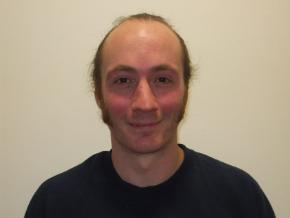Dr David Boldrin
Published: 19 February 2020
Magnetism/Functional Materials

Dr David Boldrin
School of Physics and Astronomy
Type of fellowship Leverhulme ECF
Area of research Magnetism/Functional Materials
Why did you choose to pursue a fellowship in your research career?
I’ve always enjoyed research since the first day I stepped in the lab for my undergraduate research project. I’ve never really considered doing anything else since then (except a brief fling with brewing!). After post-doc-ing for a while I realised that it was not sustainable in the long term and a fellowship offered an excellent route into a more stable and independent career in academia, so I just went for it. I never expected to get anything, but I got lucky!
Why work at the University of Glasgow?
I have been very fortunate that Glasgow has turned into a happy meeting point between two parts of my life: family and work. Familywise, I met my Glaswegian wife when I was in London 10 years ago. We have planned to move up here for a while, even if it meant giving up academia, and she is now delighted that our son will speak Glasgow patter. Work-wise, the research undertaken at the University, both in Physics and Chemistry, was an excellent fit to what I was interested in pursuing. In particular, I’m looking forward to learning a new technique, electron microscopy, for imaging and characterising my materials at the atomic scale. Not many better places in the world to learn this than within the MCMP group in Physics.
How would you describe your research in 20 words or less?
Trying to make things cooler with magnets (in more ways than one!)
What is your research highlight?
For a long time I worked at making a synthetic version of a rare, naturally occurring mineral,
Vésigniéite, in the lab. It had a lovely green colour and I even remember seeing a beautiful crystal of it in a museum that had been found in a mine near where my parents are in Leicester. It had strange magnetic properties and is what we would call ‘magnetically frustrated’, i.e. it really wanted to be a magnet but wasn’t! After my Ph.D. and many, many experiments we were able to reveal its fundamental magnetic properties and published an article in Physical Review Letters that explained its internal confliction! Pretty boring for most people, but it was a fun puzzle that needed many pieces to come together to solve.
What do you look for in a collaboration?
It sounds corny, but it always helps to get along well with people when collaborating! Which in a collaboration usually comes about by being friendly, cooperative and respecting other people’s aims.
How do you see your research impacting society?
Whilst my Ph.D. was focussed on blue skies research, I have since become interested in applications within the same material families. Whilst it’s far easier to argue the societal impact of the latter, I’ve always felt that every result, interesting at the time or not, is another rung on the ladder towards new discoveries and technologies. For instance, my current project is to investigate new magnetic materials for energy efficient refrigeration, so the societal impact is clear. But the physics that underpins the pertinent properties was originally studied in very different materials, with zero applications. I can now use this fundamental understanding to try and design better performing materials for our fridges!
What next?
I’ve barely started! I’m enjoying getting stuck into my research project and not thinking too much about what’s next….
First published: 19 February 2020

